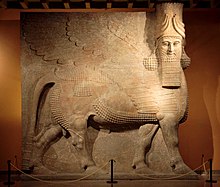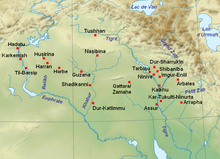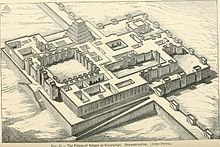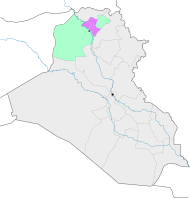Dur-Sharrukin

Multi tool use
ܕܘܪ ܫܪܘ ܘܟܢ (in Syriac) دور شروكين (in Arabic) | |
 A human-headed winged bull known as a lamassu from Dur-Sharrukin. Neo-Assyrian Period, ca. 721–705 BC | |
 Shown within Iraq | |
| Alternative name | Khorsabad |
|---|---|
| Location | Khorsabad, Nineveh Province, Iraq |
| Region | Mesopotamia |
| Coordinates | 36°30′34″N 43°13′46″E / 36.50944°N 43.22944°E / 36.50944; 43.22944Coordinates: 36°30′34″N 43°13′46″E / 36.50944°N 43.22944°E / 36.50944; 43.22944 |
| Type | Settlement |
| Length | 1,760 m (5,770 ft) |
| Width | 1,635 m (5,364 ft) |
| Area | 2.88 km2 (1.11 sq mi) |
| History | |
| Founded | In the decade preceding 706 BC |
| Abandoned | Approximately 605 BC |
| Periods | Neo-Assyrian Empire |
| Cultures | Assyrian |
| Site notes | |
| Excavation dates | 1842–1844, 1852–1855 1928–1935, 1957 |
| Archaeologists | Paul-Émile Botta, Eugène Flandin, Victor Place, Edward Chiera, Gordon Loud, Hamilton Darby, Fuad Safar |
| Condition | Destroyed/irreparably damaged |
| Public access | Inaccessible |
Dur-Sharrukin ("Fortress of Sargon"; Arabic: دور شروكين), present day Khorsabad, was the Assyrian capital in the time of Sargon II of Assyria. Khorsabad is a village in northern Iraq, 15 km northeast of Mosul. The great city was entirely built in the decade preceding 706 BC. After the unexpected death of Sargon in battle, the capital was shifted 20 km south to Nineveh.
Contents
1 History
1.1 Destruction by ISIL
2 Features
3 Archaeology
4 See also
5 Notes
6 References
7 External links
History

Lamassu found during Botta's excavation, now in the Louvre Museum.

Mesopotamia in the Neo-Assyrian period (place names in French)
Sargon II ruled from 722 to 705 BC. The demands for timber and other materials and craftsmen, who came from as far as coastal Phoenicia, are documented in contemporary Assyrian letters. The debts of construction workers were nullified in order to attract a sufficient labour force. The land in the environs of the town was taken under cultivation, and olive groves were planted to increase Assyria's deficient oil-production. The great city was entirely built in the decade preceding 706 BC, when the court moved to Dur-Sharrukin, although it was not completely finished yet. Sargon was killed during a battle in 705. After his unexpected death his son and successor Sennacherib abandoned the project, and relocated the capital with its administration to the city of Nineveh, 20 km south. The city was never completed and it was finally abandoned a century later when the Assyrian empire fell.
[1]
Destruction by ISIL
On 8 March 2015 the Islamic State of Iraq and the Levant reportedly started the plunder and demolition of Dur-Sharrukin, according to the Kurdish official from Mosul Saeed Mamuzini.[2] The Iraqi Tourism and Antiquities Ministry launched the related investigation on the same day.[2]
Features

Plan of Dur-Sharrukin, 1867

Plan of Palace of Sargon Khorsabad Reconstruction 1905

Reconstructed Model of Palace of Sargon at Khorsabad 1905

Khorsabad brick, Assyria. Babylonian; Louvre Brooklyn Museum Archives, Goodyear Archival Collection
The town was of rectangular layout and measured 1758.6 by 1635 metres. The enclosed area comprised 3 square kilometres, or 288 hectares. The length of the walls was 16280 Assyrian units, which according to Sargon himself corresponded to the numerical value of his name.[3] The city walls were massive and 157 towers protected its sides. Seven gates entered the city from all directions. A walled terrace contained temples and the royal palace. The main temples were dedicated to the gods Nabu, Shamash and Sin, while Adad, Ningal and Ninurta had smaller shrines. A temple tower, ziggurat, was also constructed. The palace was adorned with sculptures and wall reliefs, and the gates were flanked with winged-bull shedu statues weighing up to 40 tons. Sargon supposedly lost at least one of these winged bulls in the river.
In addition to the great city, there was a royal hunting park and a garden that included "all the aromatic plants of Hatti[4] and the fruit-trees of every mountain", a "record of power and conquest", as Robin Lane Fox has observed.[5] Surviving correspondence mentions the moving of thousands of young fruit trees, quinces, almonds, apples and medlars.[6]
"On the central canal of Sargon's garden stood a pillared pleasure-pavilion which looked up to a great topographic creation: a man-made Garden Mound. This Mound was planted with cedars and cypresses and was modelled after a foreign landscape, the Amanus mountains in north Syria, which had so amazed the Assyrian kings. In their flat palace-gardens they built a replica of what they had encountered."[7]
Archaeology

Dur-Sharrukin foundation cylinder

Palace of Dur-Sharrukin

Sargon II (left) faces a high-ranking official, possibly Sennacherib his son and crown prince. 710-705 BCE. From Khorsabad, Iraq. The British Museum, London
Dur-Sharrukin is roughly a square with a border marked by a city wall 24 meters thick with a stone foundation pierced
by seven massive gates. A mound in the northeast section marks the location of the palace of Sargon II. At the time of its construction, the village on the site was named Maganuba.
[8]
The site was first noticed by the French Consul General at Mosul, Paul-Émile Botta in 1842. Botta believed, however, that Khorsabad was the site of biblical Nineveh. The site was excavated by Botta in 1842-44, joined in the later stages by artist Eugène Flandin.[9][10] Victor Place resumed the excavations from 1852 to 1855.[11][12]
A significant number of the items recovered by the French at Dur-Sharrukin were lost in two river shipping incidents. In 1853, Place attempted to move two 30-ton statues and other material to Paris from Khorsabad on a large boat and four rafts. All of the vessels except two of the rafts were scuttled by pirates. In 1855, Place and Jules Oppert attempted to transport the remaining finds from Dur-Sharrukin, as well as material from other sites being worked by the French, mainly Nimrud. Almost all of the collection, over 200 crates, was lost in the river.[13] Surviving artifacts from this excavation were taken to the Louvre in Paris.
The site of Khorsabad was excavated 1928–1935 by American archaeologists from the Oriental Institute in Chicago. Work in the first season was led by Edward Chiera and concentrated on the palace area. A colossal bull estimated to weigh 40 tons was uncovered outside the throne room. It was found split into three large fragments. The torso alone weighed about 20 tons. This was shipped to Chicago. The preparation and shipment of the bull back to the Oriental Institute was incredibly arduous. The remaining seasons were led by Gordon Loud and Hamilton Darby. Their work examined one of the city gates, continued work at the palace, and excavated extensively at the palace's temple complex.[14] Since Dur-Sharrukin was a single-period site that was evacuated in an orderly manner after the death of Sargon II, few individual objects were found. The primary discoveries from Khorsabad shed light on Assyrian art and architecture.
In 1957, archaeologists from the Iraqi Department Antiquities, led by Fuad Safar excavated at the site, uncovering the temple of Sibitti.[15]
See also
- Cities of the ancient Near East
- Destruction of cultural heritage by ISIL
- Short chronology timeline
- List of megalithic sites
Notes
^ Marc Van De Mieroop, A History of the Ancient Near East ca. 3000 - 323 BC, (Wiley-Blackwell) 2006, .mw-parser-output cite.citationfont-style:inherit.mw-parser-output .citation qquotes:"""""""'""'".mw-parser-output .citation .cs1-lock-free abackground:url("//upload.wikimedia.org/wikipedia/commons/thumb/6/65/Lock-green.svg/9px-Lock-green.svg.png")no-repeat;background-position:right .1em center.mw-parser-output .citation .cs1-lock-limited a,.mw-parser-output .citation .cs1-lock-registration abackground:url("//upload.wikimedia.org/wikipedia/commons/thumb/d/d6/Lock-gray-alt-2.svg/9px-Lock-gray-alt-2.svg.png")no-repeat;background-position:right .1em center.mw-parser-output .citation .cs1-lock-subscription abackground:url("//upload.wikimedia.org/wikipedia/commons/thumb/a/aa/Lock-red-alt-2.svg/9px-Lock-red-alt-2.svg.png")no-repeat;background-position:right .1em center.mw-parser-output .cs1-subscription,.mw-parser-output .cs1-registrationcolor:#555.mw-parser-output .cs1-subscription span,.mw-parser-output .cs1-registration spanborder-bottom:1px dotted;cursor:help.mw-parser-output .cs1-ws-icon abackground:url("//upload.wikimedia.org/wikipedia/commons/thumb/4/4c/Wikisource-logo.svg/12px-Wikisource-logo.svg.png")no-repeat;background-position:right .1em center.mw-parser-output code.cs1-codecolor:inherit;background:inherit;border:inherit;padding:inherit.mw-parser-output .cs1-hidden-errordisplay:none;font-size:100%.mw-parser-output .cs1-visible-errorfont-size:100%.mw-parser-output .cs1-maintdisplay:none;color:#33aa33;margin-left:0.3em.mw-parser-output .cs1-subscription,.mw-parser-output .cs1-registration,.mw-parser-output .cs1-formatfont-size:95%.mw-parser-output .cs1-kern-left,.mw-parser-output .cs1-kern-wl-leftpadding-left:0.2em.mw-parser-output .cs1-kern-right,.mw-parser-output .cs1-kern-wl-rightpadding-right:0.2em
ISBN 1-4051-4911-6
^ ab "Ancient site Khorsabad attacked by Islamic State: reports". Toronto Star. 8 March 2015. Retrieved 8 March 2015.
^ Fuchs, Die Inschriften Sargons II. aus Khorsabad, 42:65; 294f. See the discussion by Eckart Frahm, "Observations on the Name and Age of Sargon II and on Some Patterns of Assyrian Royal Onomastics," NABU 2005-2.44
^ Hatti: in this context, all the areas to the west of the Euphrates controlled by Neo-Hittite kingdoms.
^ D.D. Luckenbill, Ancient Records of Assyria and Babylonia, vol II:242, quoted in Robin Lane Fox, Travelling Heroes in the Epic Age of Homer 2008, pp26f.
^ Lane Fox 2008:27; texts are in Luckenbill 1927:II.
^ Lane Fox 2008:27, noting D. Stronach, "The Garden as a political statement: some case-studies from the Near East in the first millennium BC", Bulletin of the Asia Institute 4 (1990:171-80). The garden mount first documented at Dur-Sharrukin was to have a long career in the history of gardening.
^ Cultraro M., Gabellone F., Scardozzi G, Integrated Methodologies and Technologies for the Reconstructive Study of Dur-Sharrukin (Iraq), XXI International CIPA Symposium, 2007
^ Paul Emile Botta and Eugene Flandin, Monument de Ninive, in 5 volumes, Imprimerie nationale, 1946-50
^ E. Guralnick, New drawings of Khorsabad sculptures by Paul Émile Botta, Revue d'assyriologie et d'archéologie orientale, vol. 95, pp. 23-56, 2002
^ Victor Place, Nineve et l'Assyie, in 3 volumes, Imprimerie impériale, 1867–1879
^ Joseph Bonomi, Ninevah and Its Palaces: The Discoveries of Botta and Layard, Applied to the Elucidation of Holy Writ, Bohn, 1957 (2003 Reprint, Gorgias Press LLC,
ISBN 1-59333-067-7)
^ Robert William Rogers, A history of Babylonia and Assyria: Volume 1, Abingdon Press, 1915
^ [1] OIC 16. Tell Asmar, Khafaje and Khorsabad: Second Preliminary Report of the Iraq Expedition, Henri Frankfort, 1933; [2] OIC 17. Iraq Excavations of the Oriental Institute 1932/33: Third Preliminary Report of the Iraq Expedition, Henri Frankfort, 1934; [3] Gordon Loud, Khorsabad, Part 1: Excavations in the Palace and at a City Gate, Oriental Institute Publications 38, University of Chicago Press, 1936; [4] Gordon Loud and Charles B. Altman, Khorsabad, Part 2: The Citadel and the Town, Oriental Institute Publications 40, University of Chicago Press, 1938
^ F. Safar, "The Temple of Sibitti at Khorsabad", Sumer 13 (1957:219-21).
References
[5] Buckingham, James Silk, The buried city of the East, Nineveh: a narrative of the discoveries of Mr. Layard and M. Botta at Nimroud and Khorsabad, National Illustrated Library, 1851- A. Fuchs, Die Inschriften Sargons II. aus Khorsabad, Cuvillier, 1994,
ISBN 3-930340-42-9 - A. Caubet, Khorsabad: le palais de Sargon II, roi d'Assyrie: Actes du colloque organisé au musée du Louvre par le Services culturel les 21 et 22 janvier 1994, La Documentation française, 1996,
ISBN 2-11-003416-5 - Guralnick, Eleanor, "The Palace at Khorsabad: A Storeroom Excavation Project." In D. Kertai and P. A. Miglus (eds.) New Research on Late Assyrian Palaces. Conference at Heidelberg January 22nd, 2011, 5–10. Heidelberger Studien zum Alten Orient 15. Heidelberg: Heidelberger Orientverlag, 2013
- Arno Poebel, The Assyrian King-List from Khorsabad, Journal of Near Eastern Studies, vol. 1, no. 3, pp. 247–306, 1942
- Arno Poebel, The Assyrian King List from Khorsabad (Continued), Journal of Near Eastern Studies, vol. 1, no. 4, pp. 460–492, 1942
- Pauline Albenda, The palace of Sargon, King of Assyria: Monumental wall reliefs at Dur-Sharrukin, from original drawings made at the time of their discovery in 1843–1844 by Botta and Flandin, Editions Recherche sur les civilisations, 1986,
ISBN 2-86538-152-8
External links
| Wikimedia Commons has media related to Dur-Sharrukin. |
- Khorsabad Relief Project - Oriental Institute
- New York Public Library
ElVLsK6RgAXGDfNuwYT1O o,bGGpgCBYJvL65Cd4NEJLIU BqRFegBoIeJ783h VT4X3xtIQ,ZkNkIcG4cuGH5OJGJX
